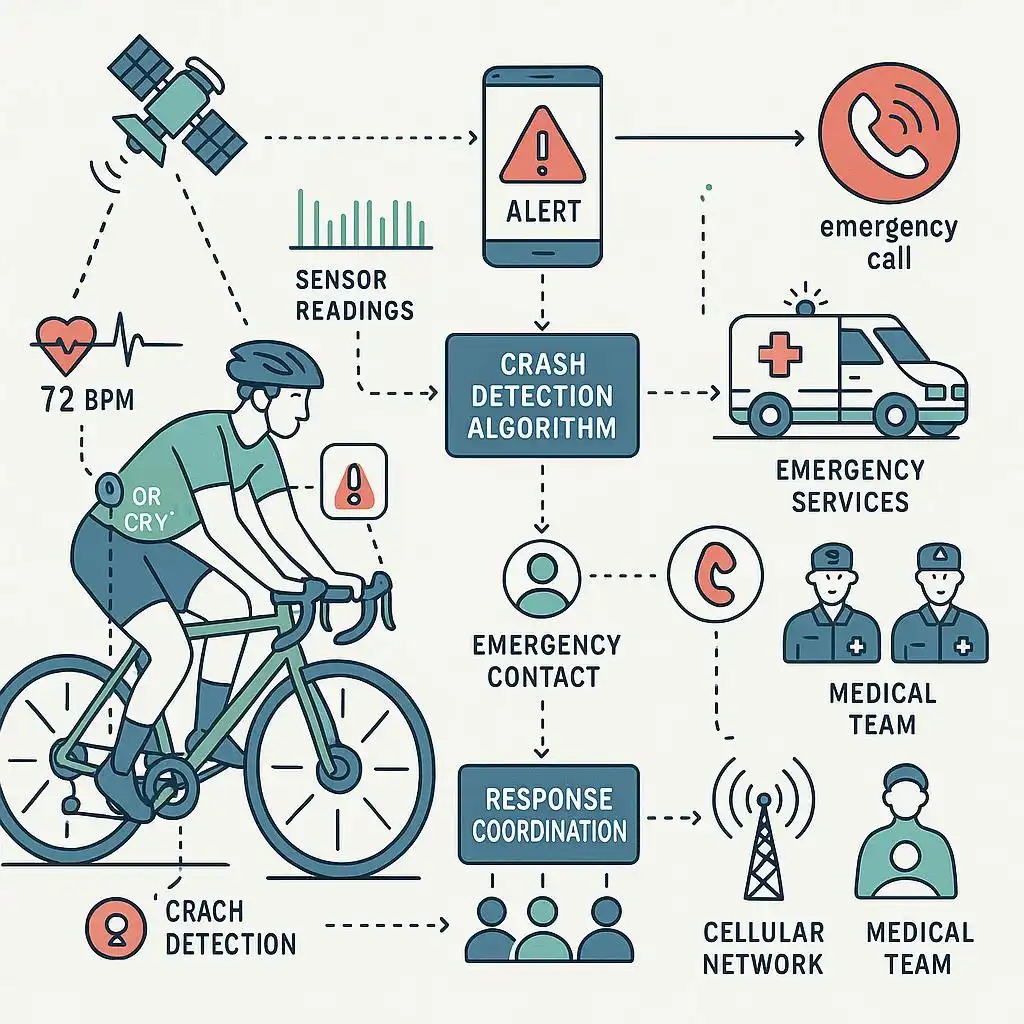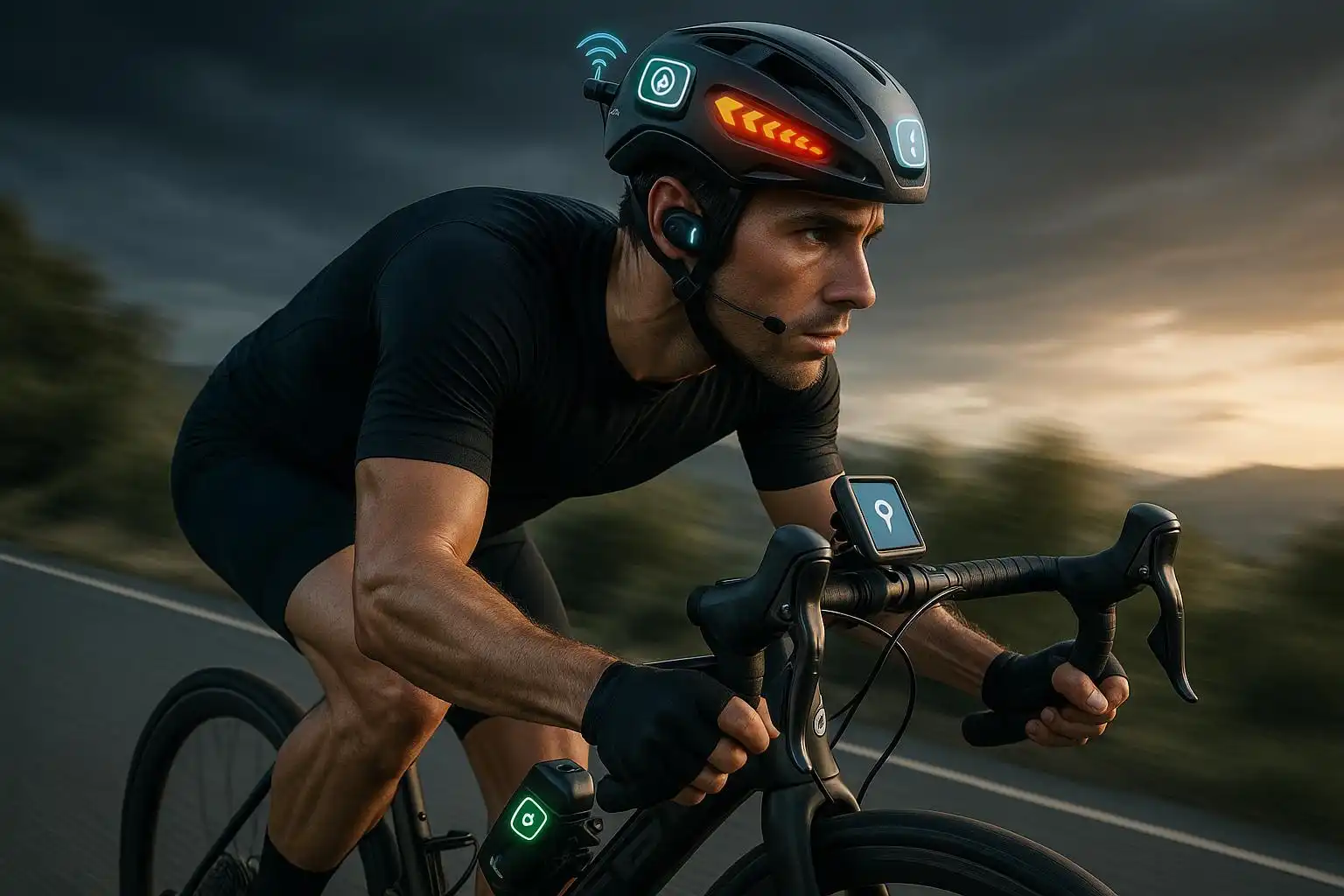The cycling world is experiencing a profound transformation in safety technology that promises to fundamentally change how we protect riders across all disciplines and skill levels. The tragic death of Swiss cyclist Muriel Furrer at the 2024 UCI Road World Championships has catalyzed an unprecedented acceleration in the development and implementation of smart safety systems, with 2025 emerging as the pivotal year when advanced GPS tracking, crash detection, and emergency response technologies transition from experimental concepts to mandatory safety standards in professional cycling and accessible solutions for recreational riders.
The announcement that all riders will compete with GPS tracking devices at the 2025 UCI Road World Championships in Rwanda represents more than just a regulatory response to tragedy—it signals the beginning of a new era where technology serves as an invisible safety net, capable of detecting emergencies, pinpointing exact locations, and coordinating rapid response efforts with unprecedented precision and speed. This technological revolution extends far beyond professional racing, encompassing smart helmets with integrated communication systems, bike-mounted cameras with incident detection capabilities, and comprehensive safety ecosystems that transform how cyclists interact with their environment and emergency services.
The convergence of GPS technology, artificial intelligence, motion sensors, and wireless communication networks has created opportunities for safety innovations that were unimaginable just a few years ago. These systems operate seamlessly in the background, monitoring rider behavior, detecting anomalies, and providing real-time data to support networks that can respond to emergencies within seconds rather than minutes or hours. The integration of these technologies with existing cycling infrastructure, from professional race management systems to consumer smartphone applications, creates comprehensive safety networks that protect riders whether they’re competing in the Tour de France or commuting to work on urban bike paths.
The implications of this safety technology revolution extend beyond immediate emergency response to encompass preventive safety measures, training optimization, and long-term health monitoring that can identify potential risks before they become critical situations. The data generated by these systems provides unprecedented insights into cycling safety patterns, accident causation factors, and effective intervention strategies that inform both individual safety practices and broader policy decisions affecting cycling infrastructure and regulations.
The Genesis of Modern Cycling Safety Technology
The development of smart cycling safety technology represents the culmination of decades of advancement in multiple technological domains, from satellite navigation systems originally developed for military applications to miniaturized sensors and wireless communication protocols that enable real-time data transmission from moving vehicles. The integration of these technologies into cycling-specific applications has been driven by the unique challenges of protecting riders who operate in dynamic environments with limited protection and high vulnerability to both mechanical failures and external hazards.
The tragic circumstances surrounding Muriel Furrer’s death at the 2024 World Championships highlighted critical gaps in traditional safety protocols, particularly the challenges of locating and providing rapid assistance to riders who experience emergencies in remote or difficult-to-access locations. According to reports, Furrer lay alone for almost an hour and a half before being discovered, a delay that might have been prevented with modern GPS tracking and automated emergency detection systems [1]. This incident served as a catalyst for the UCI’s SafeR initiative, which aims to implement comprehensive safety tracking software and establish protocols that provide real-time data to race control, medical teams, and UCI Commissaires.
The technological foundation for modern cycling safety systems rests on the integration of Global Positioning System (GPS) technology with advanced sensor arrays that can detect a wide range of anomalous conditions. These systems monitor multiple parameters simultaneously, including bike movement patterns, speed changes, orientation shifts, and impact forces, using sophisticated algorithms to distinguish between normal riding conditions and potential emergency situations. The challenge lies in developing systems sensitive enough to detect genuine emergencies while avoiding false alarms that could overwhelm response systems and reduce overall effectiveness.
The wireless communication infrastructure that enables these safety systems has evolved dramatically in recent years, with the proliferation of cellular networks, satellite communication systems, and mesh networking protocols that ensure reliable data transmission even in remote locations with limited traditional connectivity. The integration of multiple communication pathways creates redundant systems that maintain functionality even when individual network components fail, ensuring that emergency signals can reach response teams regardless of environmental conditions or infrastructure limitations.
The miniaturization of electronic components has been crucial in making advanced safety technology practical for cycling applications, where weight, aerodynamics, and power consumption are critical considerations. Modern GPS tracking devices weigh less than 25 grams and can operate for months on a single battery charge, making them suitable for integration into existing cycling equipment without significantly impacting performance or rider comfort. The development of energy-efficient processors and communication chips has enabled the creation of safety devices that provide comprehensive monitoring capabilities while maintaining the lightweight, unobtrusive characteristics essential for cycling applications.
The artificial intelligence algorithms that power modern safety systems represent perhaps the most sophisticated aspect of this technology, requiring the analysis of vast amounts of data to identify patterns that distinguish between normal riding conditions and emergency situations. These systems must account for the enormous variability in cycling conditions, from the controlled environment of professional racing to the unpredictable challenges of urban commuting or mountain biking. Machine learning approaches enable these systems to continuously improve their accuracy by learning from real-world data and adapting to new scenarios and riding conditions.

GPS Tracking Systems and Emergency Response Integration
The implementation of GPS tracking systems in cycling safety applications represents a fundamental shift from reactive to proactive safety management, enabling continuous monitoring of rider locations and conditions with the capability to automatically initiate emergency response procedures when anomalous situations are detected. The UCI’s decision to mandate GPS tracking for all riders at the 2025 World Championships demonstrates the maturation of this technology and its recognition as an essential safety tool rather than an optional enhancement.
The GPS tracking systems being deployed in professional cycling incorporate multiple layers of functionality beyond simple location monitoring. These devices continuously track rider position, speed, and movement patterns, using sophisticated algorithms to detect anomalies such as sudden stops, unexpected route deviations, or prolonged periods of inactivity that may indicate crashes or medical emergencies. The system’s ability to distinguish between planned stops and emergency situations is crucial for maintaining effectiveness while minimizing false alarms that could overwhelm response teams and reduce overall system reliability.
The integration of GPS tracking with race management systems creates comprehensive safety networks that provide real-time visibility into the status and location of every rider throughout an event. Race directors can monitor the entire field simultaneously, identifying potential safety issues before they become critical and coordinating response efforts with unprecedented precision and speed. The system’s ability to provide exact coordinates for emergency situations eliminates the time-consuming process of locating riders in distress, enabling medical teams to reach incident sites within minutes rather than the extended delays that characterized traditional response protocols.
The communication protocols that connect GPS tracking devices to emergency response systems utilize multiple redundant pathways to ensure reliable data transmission even in challenging environments. These systems typically incorporate cellular networks, satellite communication, and mesh networking capabilities that maintain connectivity regardless of terrain, weather conditions, or infrastructure limitations. The redundancy built into these communication systems is essential for maintaining safety coverage in remote locations where traditional cellular service may be unreliable or unavailable.
The data processing capabilities of modern GPS tracking systems enable real-time analysis of rider behavior patterns and environmental conditions that can predict potential safety risks before they materialize into actual emergencies. These predictive capabilities represent a significant advancement over traditional reactive safety measures, enabling proactive interventions that can prevent accidents or minimize their severity. The integration of weather data, terrain information, and traffic patterns with real-time rider tracking creates comprehensive situational awareness that supports both individual safety decisions and broader event management strategies.
The battery life and power management systems of GPS tracking devices have been optimized for extended operation without requiring frequent charging or battery replacement. Modern devices can operate continuously for several months on a single battery charge, making them practical for long-term deployment in both professional and recreational cycling applications. The development of energy-efficient processors and communication systems has been crucial in achieving this extended operational capability while maintaining the compact, lightweight form factors essential for cycling applications.
The user interface and alert systems associated with GPS tracking technology have been designed to provide clear, actionable information to both riders and response teams without creating distractions or information overload. Riders receive discrete notifications about system status and any safety alerts, while response teams have access to comprehensive dashboards that provide real-time visibility into the status and location of all monitored riders. The balance between providing sufficient information for effective safety management and avoiding information overload that could impair decision-making is a critical aspect of system design.
Smart Helmet Technology and Integrated Safety Systems
The evolution of cycling helmet technology has progressed far beyond simple impact protection to encompass comprehensive safety systems that integrate communication, navigation, crash detection, and emergency response capabilities into lightweight, aerodynamic packages that enhance rather than compromise cycling performance. The emergence of smart helmets represents a paradigm shift in cycling safety, transforming passive protective equipment into active safety systems that can prevent accidents, detect emergencies, and coordinate response efforts automatically.
The Sena S1 smart cycling helmet exemplifies the current state of integrated safety technology, combining advanced audio systems with aerodynamic design principles to create equipment that enhances both safety and performance [2]. The helmet incorporates Bluetooth connectivity, integrated speakers and microphones, and sophisticated noise management systems that enable clear communication while maintaining awareness of environmental sounds crucial for cycling safety. The integration of these technologies into the helmet structure demonstrates the potential for safety equipment to provide multiple functions without compromising the primary protective role.
The crash detection capabilities of modern smart helmets utilize multiple sensor types to identify impact events and automatically initiate emergency response procedures. Accelerometers, gyroscopes, and impact sensors work together to detect the characteristic signatures of cycling accidents, distinguishing between minor incidents that don’t require intervention and serious crashes that demand immediate medical attention. The sophistication of these detection algorithms has reached the point where they can achieve 99% accuracy in identifying genuine emergencies while maintaining extremely low false alarm rates that preserve system credibility and response capacity.
The communication systems integrated into smart helmets enable riders to maintain contact with support teams, emergency services, and other riders without the need for separate devices or the safety compromises associated with traditional headphone use. The bone conduction and directional speaker technologies employed in these systems allow riders to receive audio information while maintaining full awareness of environmental sounds such as approaching vehicles, other riders, or warning signals. This balance between connectivity and situational awareness represents a crucial advancement in cycling safety technology.
The integration of navigation and route guidance systems into smart helmets provides riders with turn-by-turn directions and route information without requiring visual attention to separate devices. Voice-guided navigation reduces the need for riders to look away from the road or trail, minimizing distraction-related safety risks while ensuring that riders can navigate efficiently to their destinations. The integration of real-time traffic and hazard information into these navigation systems provides additional safety benefits by routing riders away from dangerous conditions or alerting them to potential hazards ahead.
The power management systems of smart helmets have been optimized to provide extended operation while maintaining the lightweight characteristics essential for cycling applications. Modern smart helmets can operate for 8-12 hours on a single charge, sufficient for most cycling activities while maintaining all safety and communication functions. The development of efficient charging systems and battery management protocols ensures that these devices remain functional when needed most, with low-power modes that extend battery life during periods of reduced activity.
The integration of smart helmet technology with broader safety ecosystems creates comprehensive protection networks that extend beyond individual devices to encompass team communication, emergency response coordination, and real-time safety monitoring. These integrated systems can share information between multiple riders, coordinate group safety protocols, and provide centralized monitoring capabilities that enhance safety for both individual riders and organized groups. The networking capabilities of modern smart helmets enable the creation of mesh communication networks that maintain connectivity even when individual devices are outside the range of traditional communication infrastructure.
Crash Detection and Automated Emergency Response
The development of sophisticated crash detection systems represents one of the most significant advances in cycling safety technology, providing the capability to automatically identify emergency situations and initiate response procedures without requiring conscious action from injured riders.




